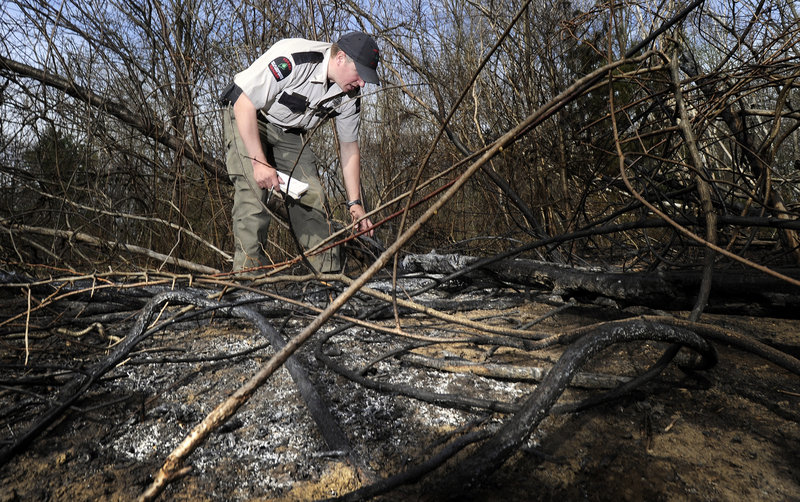Warm, dry conditions have helped to push the number of wildfires in Maine to three times the number that had been seen at this time last year.
As of Wednesday, the Maine Forest Service had investigated 229 fires, which had burned a total of 270 acres. At this time last year, 76 fires had burned 45 acres.
“Certainly it’s more than last spring. We had a lot more rain last spring,” said Kent Nelson, a fire prevention specialist for the Maine Forest Service, which investigates all outdoor fires in the state.
Nelson attributes the difference to the lack of snowpack in late winter this year, the high temperatures in March and a small amount of rainfall this month. He said the forest service handles an average of about 500 fires a year.
Most fires are caused by people with good intentions, who might get careless while burning brush or cause a spark while using a machine like a brush cutter, Nelson said.
Wednesday was a Class 4 day — the second-highest level of fire danger — for the entire state. Burning permits are not issued when the fire danger is Class 3 or above. The current fire danger coincides with Wildfire Awareness Week.
State forest rangers in Maine’s southern region are busy, particularly because there are six of them rather than the usual seven. Statewide, five forest ranger positions are vacant.
One ranger in the southern district, who is covering the Portland and Cornish areas, handled a fire in Waterboro on Wednesday morning before going to Gorham, South Portland and Sanford, said Sgt. Gregg Hesslein.
“He’s not done yet,” Hesslein said late Wednesday afternoon. “That’s kind of how it is when we’re busy.”
Gorham Deputy Fire Chief Kenneth Fickett said the current conditions are what he would normally expect in August or early September.
“The big thing is the wind and the dry ground. There’s no water in the ground at all. Everything just dries up and it’s waiting for a fire, basically,” he said.
Portland has had only 61.4 inches of snow in the year that started July 1. That’s 17.5 inches below normal, according to the National Weather Service.
In March, the city got 2 inches of rain, which was 2.19 inches less than the typical amount. So far this month, there has been only 0.16 inches of rain, below the normal level of 2.5 inches.
“So, we’ve been dry for a couple of months now,” said meteorologist Margaret Curtis. “At this point, this is just considered a short-term drought. You hear them talking about drought in Texas. We’re not nearly at their level.”
The fires come at a time when recruitment and retention can pose challenges for fire departments that rely on call and volunteer firefighters.
Training requirements can be a hurdle because they are the same for career, volunteer and call firefighters, said Stephen Nichols, president of the Maine Fire Chiefs Association.
Nichols, who is Kennebunk’s fire chief, said a good number of call firefighters — perhaps 30 to 35 — typically come out when there’s a reported woods or structure fire in town. But it can be difficult for people to get out of their jobs to respond to smaller issues like alarms or trash can fires.
“We still depend a lot on our call staff,” Nichols said. “Some days we get some, some days we don’t. If we don’t, we start calling mutual aid.”
Lebanon Fire Chief Skip Wood said about 10 communities sent a total of 80 firefighters to a fire in the woods in town on Tuesday night. About three acres burned.
Mutual aid was important to the all-volunteer department, in part because of the need to relieve firefighters.
“You don’t have nearly enough people to do everything,” Wood said.
Staff Writer Ann S. Kim can be contacted at 791-6383 or at:
akim@pressherald.com
Twitter: AnnKimPPH
Send questions/comments to the editors.



Success. Please wait for the page to reload. If the page does not reload within 5 seconds, please refresh the page.
Enter your email and password to access comments.
Hi, to comment on stories you must . This profile is in addition to your subscription and website login.
Already have a commenting profile? .
Invalid username/password.
Please check your email to confirm and complete your registration.
Only subscribers are eligible to post comments. Please subscribe or login first for digital access. Here’s why.
Use the form below to reset your password. When you've submitted your account email, we will send an email with a reset code.